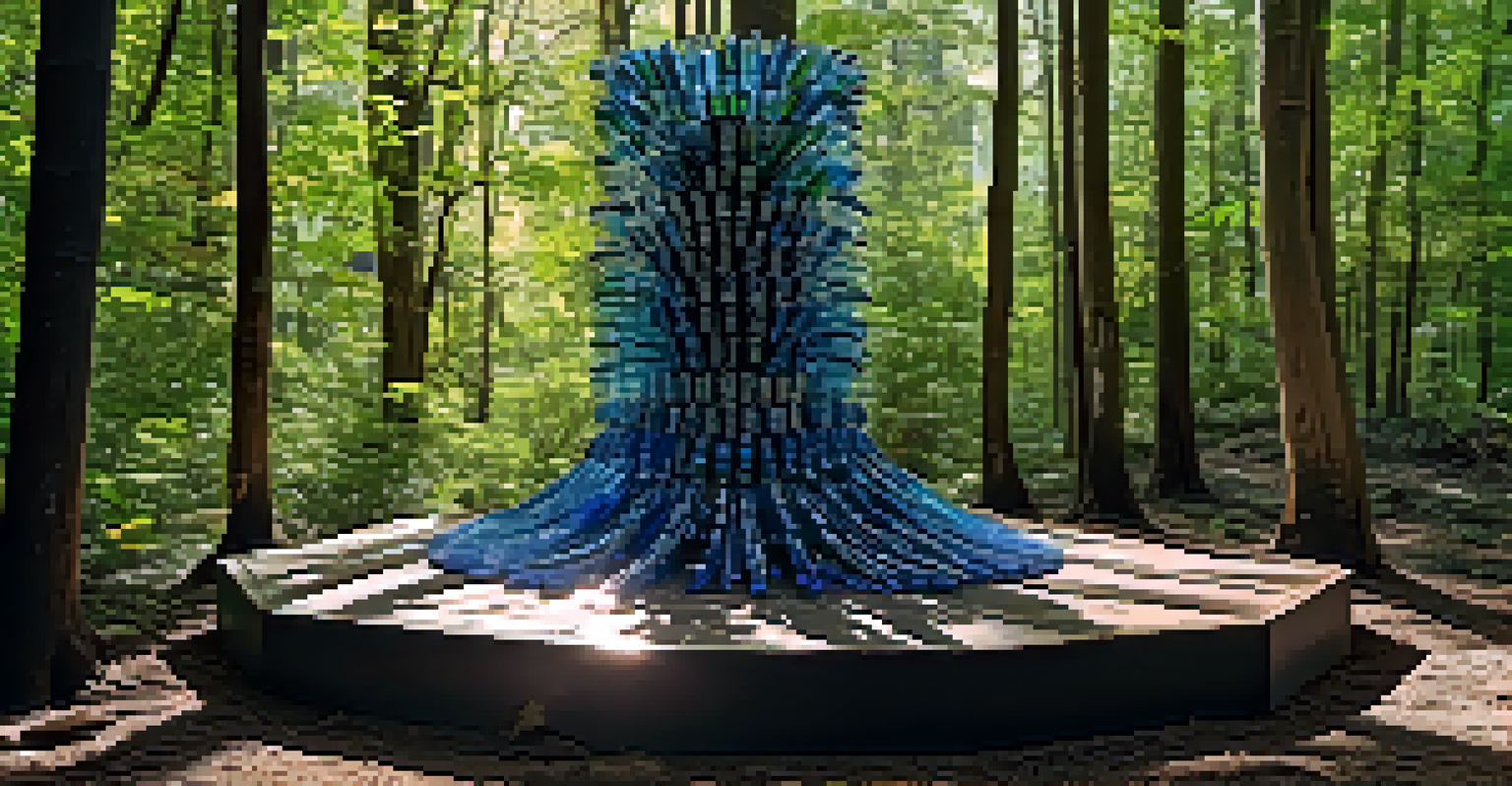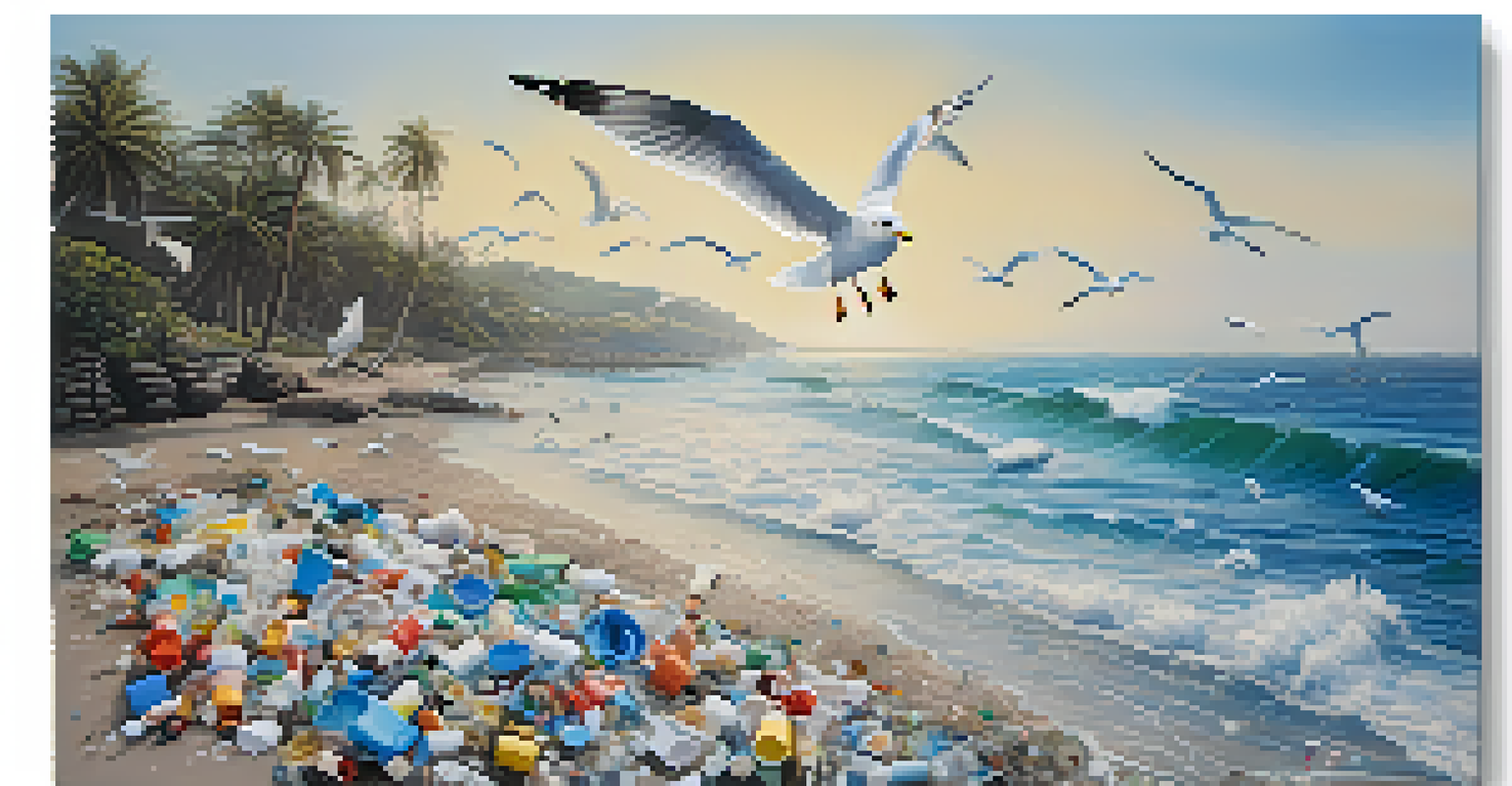Eco-Art: Nature's Impact on Environmental Artistic Movements

Understanding Eco-Art and Its Origins
Eco-art is a form of artistic expression that emphasizes the relationship between art and the environment. Emerging in the late 20th century, it reflects the growing awareness of ecological issues. Artists began to use their work as a platform to spark conversation about climate change, conservation, and sustainability.
Art is not a mirror held up to reality, but a hammer with which to shape it.
The roots of eco-art can be traced back to movements like Land Art, where artists integrated natural landscapes into their creations. This approach challenged traditional notions of art, moving it away from galleries and into the great outdoors. By doing so, artists invited audiences to engage with nature in a more profound way.
Today, eco-art continues to evolve, often incorporating recycled materials and innovative techniques. This evolution not only showcases the creativity of artists but also serves as a reminder of our responsibility to protect the planet. In essence, eco-art is a call to action wrapped in beauty.
The Role of Nature in Eco-Art
Nature plays a central role in eco-art, serving as both inspiration and medium. Artists often draw from the natural world to create pieces that highlight its beauty or its degradation. This connection creates a powerful dialogue about environmental issues, prompting viewers to reflect on their relationship with the Earth.

For instance, artists like Andy Goldsworthy use natural materials like leaves, stones, and ice to create temporary installations that blend seamlessly into their surroundings. These works not only celebrate the beauty of nature but also underscore its fragility. When the elements inevitably change these artworks, they serve as a reminder of nature's impermanence.
Eco-Art Merges Art and Nature
Eco-art emphasizes the relationship between artistic expression and environmental awareness, encouraging dialogue about ecological issues.
By engaging with nature directly, eco-artists encourage a deeper appreciation for the environment. Their works often evoke emotions that can lead to a greater desire for conservation. In this way, nature becomes a collaborator in the creative process, enriching both the art and the message.
Eco-Art as a Tool for Environmental Advocacy
Eco-art is more than just aesthetic; it serves as a powerful tool for advocacy. Artists often create pieces that address specific environmental issues, from pollution to deforestation. By raising awareness through their work, they can inspire action and change in their communities.
The Earth does not belong to us; we belong to the Earth.
For example, the artist Christo and Jeanne-Claude famously wrapped the Reichstag building in fabric to draw attention to environmental concerns in urban spaces. This bold statement not only captivated onlookers but also sparked discussions about how art can influence public perception of ecological issues. Their work exemplifies how art can serve as a catalyst for dialogue about the environment.
Through exhibitions, installations, and public artworks, eco-artists can reach diverse audiences. Their ability to blend art with activism makes eco-art a unique and effective way to promote environmental consciousness. Ultimately, eco-art invites everyone to participate in the conversation about our planet's future.
Examples of Prominent Eco-Art Artists
Several artists have made significant contributions to the eco-art movement, each with their unique approach. One notable figure is Agnes Meyer-Brandis, who explores the relationship between humanity and the cosmos through her art. Her work encourages viewers to consider our place within the larger ecological system.
Another influential artist is Olafur Eliasson, known for his large-scale installations that often incorporate natural elements. His work, like 'The Weather Project' at the Tate Modern, creates immersive experiences that encourage viewers to engage with environmental themes. Eliasson’s art is not just visual; it evokes a sensory understanding of climate issues.
Art as Environmental Advocacy
Eco-art serves as a powerful tool for advocacy, addressing specific environmental problems and inspiring community action.
These artists, among many others, demonstrate the diverse ways in which eco-art can be expressed. Their innovative approaches challenge viewers to reconsider their connection to the environment. Through their work, they not only create art but also foster a deeper awareness of ecological challenges.
The Impact of Eco-Art on Community Engagement
Eco-art has a remarkable ability to engage local communities in environmental issues. Many artists collaborate with community members to create projects that reflect local ecological concerns. This participatory approach empowers individuals and fosters a sense of ownership over environmental stewardship.
For instance, community gardens often serve as living artworks where local residents come together to cultivate plants while learning about sustainability. These spaces not only beautify neighborhoods but also promote biodiversity and food security. Eco-art transforms public spaces into interactive learning environments.
By involving communities in the creative process, eco-art helps to build connections between people and their environment. These projects often lead to increased awareness of local ecosystems and inspire collective action. In this way, eco-art extends its impact beyond the canvas, nurturing a culture of environmental responsibility.
Eco-Art and Climate Change Awareness
In recent years, eco-art has taken on an urgent role in raising awareness about climate change. Artists use their platforms to address the pressing issues of global warming, habitat loss, and pollution. By creating thought-provoking pieces, they can spark conversations that inspire change in attitudes and behaviors.
For example, the 'The Ocean Cleanup' project uses art to highlight the impact of plastic pollution in our oceans. By visually representing the scale of the problem, the project not only raises awareness but also encourages action to combat this growing crisis. Such initiatives underscore the importance of art in communicating complex environmental issues.
Future of Eco-Art is Promising
The future of eco-art looks bright as artists increasingly explore innovative methods to raise awareness and inspire change regarding environmental challenges.
As climate change continues to dominate headlines, eco-art remains a vital medium for discussion. It not only educates but also empowers individuals to take action. Through their creativity, eco-artists help to illuminate the path toward a more sustainable future.
The Future of Eco-Art and Environmental Movements
The future of eco-art appears bright, as the intersection of art and environmentalism grows stronger. As awareness of climate issues increases, more artists are likely to explore eco-art as a medium for expression and advocacy. This trend signals a shift in how we perceive our role in the environment and the power of creativity to drive change.
Emerging technologies, such as virtual reality and interactive installations, offer exciting new avenues for eco-artists. These innovations can create immersive experiences that engage audiences in ways traditional media cannot. By leveraging technology, artists can deepen the impact of their message and reach wider audiences.

Ultimately, the evolution of eco-art will continue to reflect society's changing relationship with nature. As we face unprecedented environmental challenges, the role of art in addressing these issues will remain crucial. Eco-art provides a hopeful lens through which we can envision a sustainable future for our planet.